Dr Xander van Lill
Prof Brandon Morgan
Pakeezah Rajab
Using Vocational Interests in Organisational Selection and Development
Introduction
Vocational interests,
sometimes also called career interests, form an integral part of career counselling (e.g., Morgan et al., 2019). However, their use outside...
...of this context appears to be far more limited. This is potentially due to the historical split between counselling psychology and organisational/work psychology (Hansen & Wiernik, 2018) and/ or because of influential studies that cast doubt on the predictive validity of interest scores (e.g., Camp & Chartrand, 1992; Spokane et al., 2000; Tinsley, 2000).
In recent years organisational/work psychologists have started to call for the (re-)inclusion of interests in organisational psychology practice (e.g., Hansen & Wiernik, 2018; Van Iddekinge et al., 2011; Wiernik, 2016). This chapter a brief overview of vocational interests and their application to the organisational context. We start with a definition of vocational interests and then discuss the structure of vocational interests. Hereafter we discuss the relationships between vocational interests and personality and cognitive abilities. This is followed by a summary of interest-environment fit and the predictive validity of vocational interests. The chapter concludes with some suggestions on how vocational interests might be used in organisational contexts .

Defining interests
Hansen and Wiernik
(2018, p. 409, emphasis in original) define interests as "characteristic patterns of preferences for certain work activities and work environments"

Their definition covers the fundamental characteristics of vocational interests. Morgan et al. (2019) recently overviewed definitions of vocational interests and concluded that interests represent outward directed preferences for activities/environments (e.g., Rounds & Su, 2014) that motivate behaviour (e.g., Savickas, 1995). Silvia (2001) argues that interests are basic emotions that can motivate people to explore new things/tasks, help people to focus their attention on things/tasks, and that encourage persistence with these things/tasks. These three aforementioned characteristics above are of course the most commonly cited outcomes of motivation (Kanfer, 1990).
Interests are often described as trait-like due to their relative stability throughout the lifespan (Etzel & Nagy, 2021). This does not mean that there are no state-like qualities to interests (see Etzel & Nagy, 2021 and Silvia & Kashdan, 2009). Silvia (2006), for example, writes that interests can be viewed as both momentary emotion and motivation (interest) and as traits (interests). We argue here that both perspectives are complementary and important determinants of motivation/behaviour (see Silvia, 2001). In this regard, Hansen and Wiernik (2018) suggest that state interests share the same probability distribution conceptualisation that Fleeson (2001) suggested for personality traits. In other words, trait interests are the expected (mean) interests that serves as the centre of gravity and state interests the momentary fluctuations around this mean.
Models of career interests
Psychology is replete
with models used to represent abstract psychological concepts (e.g., Wiernik et al., 2020). Researchers have...

...created several different models of vocational interests since their use gained traction at the start of the last century (see Hansen & Wiernik, 2018). The most popular of these models, and the focus of this chapter, is John Holland’s model of vocational personality types1 (referred to as Holland’s model moving forward). Holland (1959) set out to develop a simple model of vocational choice that integrated existing vocational theories while retaining testable observations. He found six “major occupational environments” that summarised the US work environment (p. 35). These work environments were called (a) the motoric environment, (b) the intellectual environment, (c) the esthetic environment, (d) the supportive environment, (e) the persuasive environment, and (f) the conforming environment (Holland, 1959). The more common name for these environments is RIASEC (Realistic, Investigative, Artistic, Social, Enterprising, and Conventional).
1 Although we use the word types to be consistent with literature, these types are better thought of as factors as they do not form natural types such as in the MBTI (Wiernik, 2016).
Interest structure
Psychological theories
models are convenient abstractions consisting of a priori defined constructs that are used to explain behaviour (Wiernik et al., 2020).

Proponents of the Big Five personality model, for example, argue that there are five broad personality traits encoded in language that can explain the personality space. These five traits are called Extraversion, Emotional Stability, Intellect, Conscientiousness, and Agreeableness (e.g., Goldberg, 1990) and are thought to be relatively independent (i.e., uncorrelated). In practice, this means that we create personality inventories that provide five personality scores. Researchers typically investigate the validity of Big Five personality inventories by applying factor analysis to item responses. Factor analysis allows us to determine structure in the item responses. The internal validity of the personality inventory is supported if we find five meaningful and equally salient dimensions in the responses and if items claiming to measure each factor have the expected theoretical relationship with their respective factors. The structure of a psychological theory/model can therefore be seen as a representation of the expected relationships between constructs.
Career interests have been found to form circumplex structure , at least with respect to the RIASEC interest types. Holland, however, did not originally anticipate this structure, because he was more concerned with classification and application of interests. It was only a few years after his 1959 publication that he happened to notice that the RIASEC interest types show, what he called, a hexagonal structure (as evidenced in RIASEC correlation matrices). In this regard Holland et al. (1969, p. 3) wrote that “the [initial] arrangement of subgroups within a major class [i.e., the RIASEC classification] had no special meaning … [a] hexagonal model … was discovered somewhat accidently when we noticed that an intercorrelational matrix … used in the classification could be approximated by the distances within the hexagon”. There were no theoretical reasons for these expected relationships although Holland et al. (1969) did suggest that it was likely due to “their [the RIASEC interest types] assumed psychological similarity” (p. 18).
The hexagonal model has become synonymous with Holland’s model of vocational personality types because the model predictions became more and more aligned with the structure as the model developed over time. For example, calculation of (some) congruence indices (interest-environment fit) rely on the hexagon structure and the assumption of consistency (i.e., how well a person fits the circumplex) implicitly relies on the RIASEC interpoint distances (see Holland, 1997). The so-called circumplex model was introduced by Guttman in 1945 in his work on the structure of mental abilities. He described a circumplex model as a rise and fall pattern of relationships between variables with no start or end. This can be visualised as a sinusoid pattern in two dimensions. In Figure 1 we show this pattern with the Y-axis representing the Pearson correlation coefficient for the Realistic type and the X-axis the correlation with the RIASEC interest types. There must, of course, be some underlying structure for variables to show these relationships. That is, variables must be correlated for structure to exist. The sinusoidal pattern easily translates to variables having ordering on the circumference of a circle (Fabrigar et al., 1997).
2 Circumplex, circle, and hexagon are used synonymously to describe Holland’s hexagon. The hexagon and circle are special cases of the more general circumplex model.
FIGURE 1
Sinusoidal Pattern for the Relationship between the Realistic Interest Type and the RIASEC Interest Types
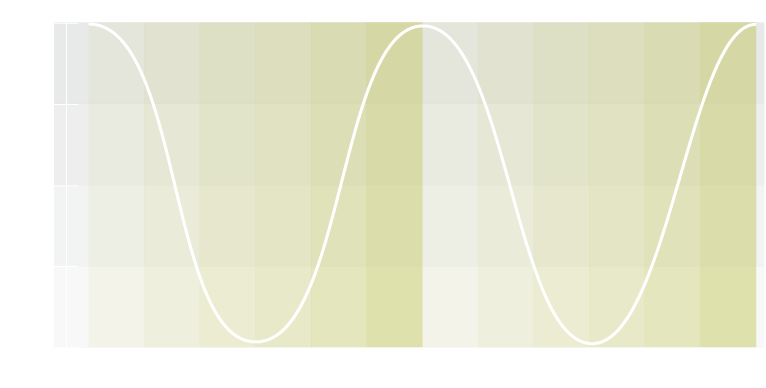
NOTE
R = REALISTIC
I = INVESTIGATIVE
A = ARTISTIC
S = CONVENTIONAL
E = ENTERPRISING
C = CONVENTIONAL
The sinusoidal pattern in this figure represents a perfect circumplex model with no general factor variance.

The number of interests debate
Debates
about the right number of variables to include in some models are not new. In trait personality, for example,
some argue that the five factors should be used, others that six factors be used, and others that facets be used (e.g., Wiernik et al., 2020). Interest researchers have made similar arguments. For example, some use the RIASEC interest types, some use eight interest types, and some prefer facet level (also called basic) interests. Tracey and Rounds (1995) argue that the circle (i.e., the circumplex) is the defining feature of the interest space and that this circle can be split into any number of interests. In Figure 2 the theoretical circumplex structure for the RIASEC interest types and eight interest types that Tracey uses are presented. There is some support for their idea (e.g., Ferreira & Morgan, 2019) but there is also evidence that interests, especially when moving into basic interests, do not always fit this circle (Wiernik, 2016). We should not be too concerned about the correct number of types though, because the choice of interests should be based on practical considerations and the purpose for which they are used. In some settings the RIASEC interest types may suffice and in other settings more than six may be necessary (see Wiernik et al., 2020 for a discussion of these issues applied to personality traits). However, as with the shifting movement in personality psychology toward using facets (e.g., Elleman, 2020), it is likely that basic interests are going to feature more prominently in future.
2 Circumplex, circle, and hexagon are used synonymously to describe Holland’s hexagon. The hexagon and circle are special cases of the more general circumplex model.
FIGURE 2
Theoretical Circumplex Representing Six and Eight Interest Types
Cross-cultural validity of the interest circumplex
The circumplex model
must be shown to be valid in the context where it is used before applying it to interest scores and their interpretation (Tao et al., 2019).

For the most part, the RIASEC circumplex is supported in the US (Wiernik, 2016). Mixed results have been found outside of the US. In South Africa there is also mixed results. Some studies found extremely poor fit (e.g., Du Toit & de Bruin, 2002), whereas other studies have found good fit (e.g., Glosenberg et al., 2019; Morgan et al., 2015; Rabie & Naidoo, 2019). Morgan (2019) conducted a meta-analysis of RIASEC correlation matrices for South African sample groups and found that older interest inventories generally showed poor fit, whereas newer interest inventories showed good fit. Mixed results are not unexpected because all research is subject to unmodelled sources of variance (see Yarkoni, 2020). This means that the fit, or lack thereof, cannot be explained solely by the instrument. Some relevant unmodelled sources of variance include, for example, age, type of measure used, item relevance, and access to occupational information, etc. These again add to uncertainty about the fit of the RIASEC circumplex model in South Africa.
Interests & personality
Holland (1997) believed
that interest measures were personality measures, or more specifically, that interests are the expression of personality.
There is mixed support for this idea because (a) interests and personality share conceptual similarities but (b) have only modest bivariate correlations (e.g., Hogan & Blake, 1999; Wiernik, 2016). Mount et al. (2005) and Wiernik (2016) conducted two large-scale meta-analyses of the interest-personality relationship. These studies showed that the largest linear relationships were between the Social interest and Extraversion, the Social interest and Openness, the Enterprising interest and Extraversion, the Investigative interest and Openness, and the Artistic interest and Openness. Tsotetsi (2020) found mostly similar results in her South African sample group. Table 1 provides an overview of meaningful (i.e., relatively consistent) correlations between personality and career interests based on the aforementioned studies.
TABLE 1
Meaningful Relationships between Interest and Personality Dimensions
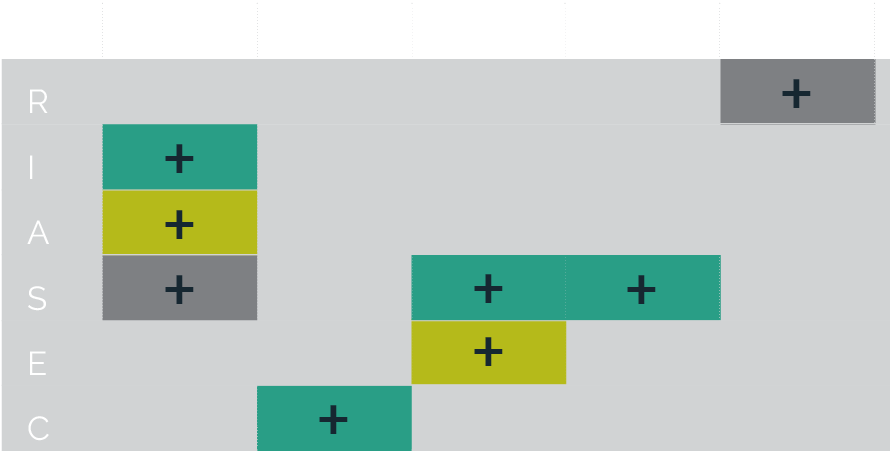
Wiernik (2016) also investigated the relationship between several personality facets and the RIASEC interest types. A summary of some of the meaningful correlation coefficients that he found are reported in Table 2.
TABLE 2
Meaningful Relationships between Interest and Personality Facets
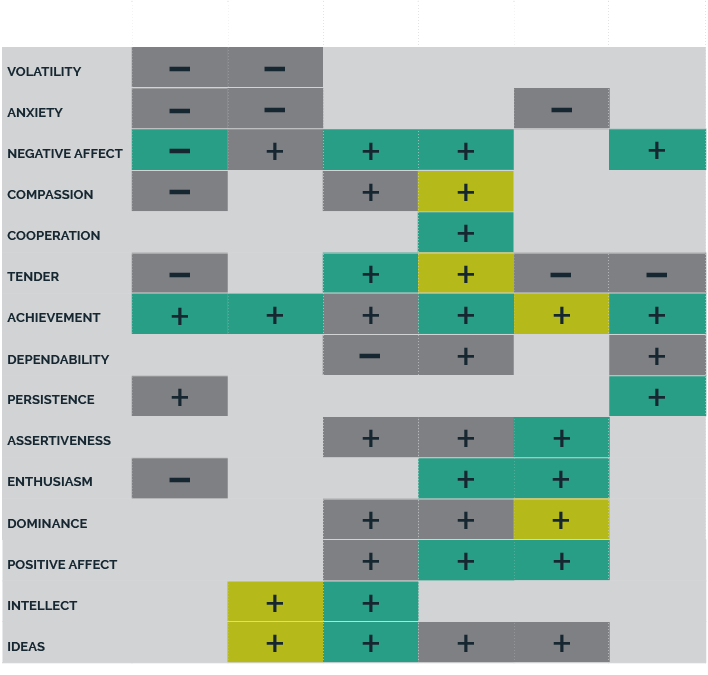
Hansen (1984) argued that the correlation coefficients between personality and interests tend to be largest on so-called social orientation and independent thought factors. These correspond roughly to Extraversion, Openness to Experience, and Conscientiousness. Hogan and Blake (1999) believed that the link between personality and interests is that personality tells us about reputation whereas interests tell us about identity (as viewed from the socio-analytic model of personality). Our view is that interests might reflect a distinction between internal and external sources of motivation. That is, as Wiernik (2016) argues, personality operates across occupations, whereas interests operate within an occupation. Mount et al. (2004) used meta-analytically derived correlation matrices to obtain spatial representations of the relationship between personality and interests. They found that the relationships were best explained in three dimensions where personality and some interests had a self-growth and achievement striving motive, but where interest scores also have a people-things motive (i.e., an interest in working with others vs. working with objects).
Wiernik (2016) clarified the relationship between interests and personality in his differential engagement model of vocational interests. This model proposes that the circumplex interest structure is closely related to between and within personality traits and cognitive abilities. In this section we refer only to the personality traits. Wiernik (2016) found that the general interest factor (discussed later in this chapter) is closely related to plasticity, defined as the shared variance between Extraversion and Openness to Experience. The interest circumplex is related to the residual variance of Extraversion and Openness to Experience (i.e., these two residual traits explain the RIASEC relationships). The residual Extraversion trait differentiates between a behavioural and interpersonal motive and the residual Openness to Experience trait differentiates between cognitive and sensory motives. Development of interests in this model is based on personality traits because people are attracted to interests that allow them to use personality strengths and avoid personality weaknesses.

Interests & cognitive ability
In this section
we discuss the relationship between cognitive ability and interests at different hierarchical levels of ability, namely, (a) general mental ability level...
... (also referred to as g) and (b) lower level of broad/specific (from here on referred to as specific) abilities. Historically, cognitive ability was thought to be a variable that should be interpreted independent of interests (e.g., Holland, 1997; Smith, 1958)
Cognitive ability appeared to be relevant to career counselling insofar as it provided context on whether an individual will be able to be successful in a career given its relative complexity compared to other careers in the same interest field (Gottfredson & Holland, 1996; Toker & Ackerman, 2012). Tracey and Rounds (1996) added a third orthogonal dimension to the interest circumplex called prestige, that seems to partially capture these ideas. The prestige is believed to represent perceived prestige, effort, and skill requirements of occupations (Sodano & Tracey, 2008), although it could also be related to education level, cognitive ability, work complexity, and values (Ackerman & Heggestad, 1997; Hansen, 1996; Lubinski, 2010; Tracey & Rounds, 1996).
Pässler et al. (2015) and Wiernik (2016) conducted a meta-analysis of cognitive abilities with vocational interests. They found that general mental ability was positively correlated with the Investigative and Artistic interests, and somewhat negatively correlated (or uncorrelated) with the Social interest. Wiernik (2016) also investigated the relationship between specific abilities and interests (see Table 3). The Realistic and Investigative interests showed positive relationships with Fluid Reasoning and Visual Processing. The Investigative interest also showed positive relationship’s Verbal Ability and Processing Speed. The Artistic interest showed positive relationships with Verbal Ability and socio-emotional abilities, and the Social interest showed positive relationships with emotional and interpersonal abilities (a full list of abilityinterest relationships can be obtained from Wiernik, 2016). The relationships between cognitive abilities and interests relative to personality-interest relationships, are comparatively less researched (Wiernik, 2016). Practitioners are encouraged to continue to review the literature to make sense of this emerging area of study and any potential implications in career counselling.

Several theoretical points of departure exist on the relationship between specific abilities and interest. Firstly, abilities, traits, and interests are argued to form trait complexes that share a common developmental origin (Ackerman et al., 2011; Wiernik, 2016). Different configurations of individual characteristics give rise to a (1) social [trait Extraversion; Social and Enterprising interests], (2) science/math [Quantitative knowledge and Visual processing abilities; Realistic and Investigative interests], (3) clerical/conventional [Processing speed ability; trait Conscientiousness; Conventional interests], or (4) intellectual/cultural [Reading and writing ability; trait Openness; Investigative and Artistic interests] complex (Ackerman & Heggestad, 1997).
A strong interest in a field might make it easier for individuals to invest significant energy and persist with enthusiasm to acquire more knowledge and demonstrate ability in a career (Ackerman et al., 2001; Silvia, 2006; Wiernik, 2016). A strong Investigative interest could, for example, direct an individual towards the development of scientific knowledge,whereas a strong Enterprising interest could direct an individual towards the acquisition of interpersonal knowledge (Ackerman, 2000). Specific abilities and interests might, therefore, be mutually reinforcing (e.g., Silvia, 2001). An alternative explanation of the relationship between specific abilities and interest focuses on the development of interests in response to an arrangement of specific abilities. Wiernik et al. (2016) argue that individuals pursue specific interest fields to capitalise on their strengths and minimise the effect of their weaknesses. Specific abilities might, therefore, tilt individuals towards forming certain interests (Lubinski, 2010). For example, a strength for Quantitative or Spatial Reasoning might lead an individual to pursue a science and math field, while a Verbal Ability could tilt an individual towards the arts and humanities. A balanced profile of abilities, in turn, could lead to the pursuit of fields such as law, business, or the social or biological sciences (Wiernik, 2016). Pässler et al.’s (2015) meta-analysis provides some support for the tilt theory of which the meta-analytical correlations are reported in Table 3.

TABLE 3
Meaningful Relationships between Interest and Cognitive Ability
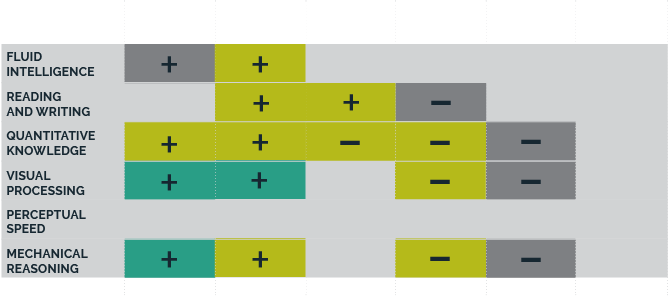
Interest level & interest profile
There is a large general
interest factor in responses to interest inventories (unless ipsative scoring is used).

This general interest factor (i.e., profile elevation) explains far more variance than the interest circumplex (Wiernik, 2016). Tracey (2012) argued that the general interest factor could be either:
(a) a nuisance factor that can be ignored,
(b) systematic bias that distorts interpretation of lower order traits (i.e., the RIASEC interest types), or
(c) variance having substantive meaning.
We believe that the general interest factor has substantive meaning and should be interpreted. As previously mentioned, Wiernik (2016) found that the general interest factor is related to plasticity. This essentially means that people who score higher on the general interest factor should find many different types of tasks motivating, even if the task deviates from their strongest interest type. Wiernik (2016, p. 158) writes that “employees with high general interests are curious and open to many opportunities at work. They are likely to be highly motivated in many different organizational roles, and they are likely to adapt quickly during rotations and receive the most benefit from these developmental assignments”.
Person-environment fit and congruence
The Person-Environment fit model is based on the premise that matching people with environments is beneficial. This process of matching should not be based on a single univariate relationship but rather incorporate the multidimensional nature of the person and environment (Jansen & Kristof-Brown, 2006). Broad dimensions that can be considered include, for example, person-vocation fit, person-job fit, person-organisation fit, person-group fit, person-value fit, and person-person fit. In this chapter we focus on fit between a person’s interests (i.e., strengths) and the interests (i.e., demands) required in a job. Holland (1997) used the term congruence to explain this type of fit. In brief, Holland (1997) argued that interest-environment fit should lead to predictable outcomes. These outcomes could be beneficial or harmful depending on the level of match.

Possible underlying mechanism of congruence-outcome relationships
A possible underlying causal mechanism for the congruence-outcome relationship might be explained using general Person-Environment fit principles. Person-Environment fit3 represents the reciprocal relationship between a person and their environment. Demands, abilities, needs, and supplies are often used as explanatory mechanisms in the Person-Environment fit model. In brief, people have skills, abilities, needs, values, etc., that can be met, not met, or exceeded in an environment. Mismatch between the person and environment (with respect to the aforementioned variables) can lead to strain, whereas interest in tasks can replenish motivational resources (see Thoman et al, 2011). This process can be compared to the strain that people experience when demands exceed resources as described in the Job-Demands Resources Model. It is therefore possible that person-environment mismatch can lead to coping and defensive behaviours and reduced motivation.
Wiernik (2016) argues that “[i]nterests reveal the types of psychological demands individuals hope to find in their work”. It is therefore possible that mismatch between interests and environment can lead to strain and attempts to adjust to the environment. These, in turn, could directly or indirectly impact on work outcomes. Nye et al. (2021) recently proposed that motivation and satisfaction mediate the relationship between interest-environment fit and academic performance. They argue that people obtain enjoyment/pleasure from doing activities that match their interests and that this motivates them to increase their effort and persistence on the task. Using more colloquial language, we interpret this as boredom vs. engagement when having to complete tasks. In this regard, Renninger (2000) argues that people can show momentary (state) interest when engaging with tasks. Pleasure associated with and continued engagement in this task can deepen interest in the task (or the associated interest domain), and these, in turn, can lead to increased value ascribed to the task and greater motivation to complete the task (Renninger, 2000).
3. We only refer to objective fit here.
Calculating congruence
There are several
different formulas/approaches that can be used to calculate congruence.
A historically popular approach that is still sometimes used today is the Brown-Gore Congruence Index (Brown & Gore, 1994). This index uses the three highest interest scores of the person and environment and applies weights to scores based on the locations of the person-environment interest codes on the circumplex. This approach requires the RIASEC interest types (or whichever interest types are used) to show the theoretical ordering (i.e., the correct circumplex structure) in both person responses and environments. Other approaches based on the circumplex model include, for example, cosine similarity, Euclidean distance, and Holland’s first letter agreement index (e.g., Holland, 1997; Xu & Li, 2020).
Edwards (1994) has criticised person-environment fit indices, such as the ones mentioned above, because of the arbitrary mathematical constraints that they place on relationships. He proposed that polynomial regression be used to calculate congruence instead. Polynomial regression is useful in research settings but can be difficult to implement in practical settings. Response surfaces can therefore be created to visually represent the congruence relationship (e.g., Nye et al., 2018). One difficulty in applying polynomial regression is that commensurate person and environment scores are needed for the results to be meaningful (see Schönbrodt, n.d.). A relatively simple approach that does not explicitly rest on circumplex structure is profile correlation. This is the row-wise (i.e., for each person and each environment) Pearson correlation coefficient (see Xu & Li, 2020). Edwards (1994), however, writes that profile correlation coefficients also place unreasonable constraints on relationships and therefore have the same limitations as the previous circumplex-based measures.
Wiernik (2016) suggests that criterion pattern profile analysis be used instead. His proposed approach is to obtain dependent variable scores on some variable (e.g., job satisfaction) for people in one type of environment/job and then apply criterion pattern profile analysis to determine the RIASEC profile that predicts the variable in that environment. For example, we might be interested in predicting job satisfaction in our sales staff. We could administer some job satisfaction measure and an interest inventory and then use criterion pattern profile analysis to obtain an interest profile that predicts job satisfaction. Individual interest profile scores can then be used to match people to the environment. In Figure 3 below is a hypothetical RIASEC interest profile that predicts some relevant criterion variable.
FIGURE 3
Hypothetical Criterion Pattern Profile Analysis

The criterion pattern in the example explained 4% of the variance in the criterion variable4. The black lines indicate the criterion pattern RIASEC profile (the vertical black lines are the 95% confidence intervals used to test for statistical significance of each interest type in the pattern) and the dashed green line is the hypothetical RIASEC profile of one candidate. Criterion pattern profile analysis showed that interest profiles with high scores on Realistic and Artistic and low scores on Social and Enterprising were related to the criterion. The correlation between the criterion pattern profile and the candidate’s RIASEC profile was .35. This suggests that there is some correspondence between the RIASEC interest profile of the candidate and the RIASEC criterion pattern profile predicting whichever relevant criterion pattern in one type of environment/job.
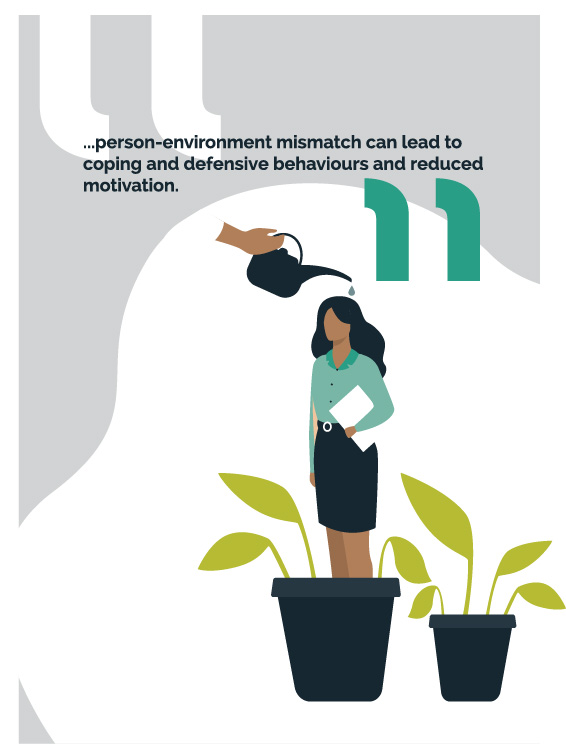
4. Granted, this is not really enough explained variance to be considered meaningful. It is just used here as an example of the application.
Predictive validity of interest and congruence scores
In this section we report on the predictive validity of congruence on relevant organisational variables. Holland (1997) believed that congruence matters, and it is therefore worthwhile to match people to environments that interest them. This hypothesis has been subject to much critique. For example, Tinsley (2000) wrote that “[t]he evidence supports the conclusion that person–environment congruence on Holland’s RIASEC dimensions is not a useful predictor of important vocational outcomes such as satisfaction, stability, achievement persistence, and job performance” (p. 155). That said, his conclusion does depend on several conditions. Some of the difficulties in establishing congruence relationships are that traditional techniques used to calculate congruence are generally flawed and tend to underestimate relationships (Tinsley, 2000; Wiernik, 2016) and that interest relevance is usually not controlled (Van Iddenkinge et al., 2011). In other words, in some jobs some interests are more important than in other jobs.
A number of meta-analysis have been conducted in the last few years providing a better view of the importance of congruence. Van Iddenkinge et al. (2011), for example, found that the match between interests and the environment was related to job performance, training performance, turnover intentions, and actual turnover, albeit with rather small effect sizes. However, after controlling for relevant moderators, such as interest relevance, the effect size did increase quite substantially. Wiernik’s (2016) meta-analysis found similar results when using typical congruence indices. However, when applying criterion pattern profile analysis as a measure of congruence, these relationships drastically increased, but (as expected) only in some occupations. In other words, congruence is not a universal fit-all idea but rather depends on the type of job a person works in. There is also evidence from two recent longitudinal studies that congruence remains relatively stable over time and that congruence is related to work/educational satisfaction (Etzel & Nagy, 2021; Nye et al., 2021).
Wiernik (2016) further investigated if congruence predicts work performance and work satisfaction over and above general mental ability and the Big Five personality traits for six different occupations. He found that interests do have predictive validity after controlling for these aforementioned factors. However, the predictive validity varied across occupations, with little incremental validity in some occupations and large incremental validity in other occupations. This again supports the idea that congruence matters more for some occupations than for others. Schmidt et al. (n.d) also found that congruence has predictive validity after controlling for general mental ability. Their results further showed that the predictive validity of interests is stronger than other commonly used organisational variables, such as some personality traits, peer ratings, and job knowledge tests5. It would seem prudent to again consider these results as variable across organisations rather than as some fixed effect applicable to all occupations. In summary, there is evidence that congruence does matter and should be measured, but that the relationship is moderated by different types of occupations.
5. The reader is referred to their article for the full list of other variables.
Practical applications
Wiernik (2016) made
several recommendations for the use of interest scores in organisational settings.
Our use of his material does not mean that we necessarily endorse his views. We leave that decision with the reader.
With respect to personal selection, Wiernik (2016) suggests that personality and interests represent different types of motivation. Personality traits tend to generalise across occupations where interests matter within jobs. This suggests that personality and interest assessment be used in selection settings. Of course, as Wiernik (2016) notes, the within interest motivation requires a thorough job-interest relevance assessment within specific jobs rather than using interest scores to represent all jobs. In addition, it could be beneficial to use occupation specific interest measures rather than the typical interest measures used for career counselling (Wiernik, 2016). One reason for this is that items can then be written that specifically reflect activities in the job rather than some broad statement (e.g., use statistical software to create big data models vs. use computers). Criterion pattern profile analysis is one technique that could potentially be used to compare candidates with the criterion pattern profile for some important outcome variable (e.g., satisfaction, performance, etc) within a job (Wiernik, 2016).
Within organisations, psychologists could consider using interest measures to help increase employee motivation by understanding the types of tasks that they like (i.e., motivate them) and tasks that frustrate them (within consideration of the general interest factor and interest strength). This approach might also be used to assign tasks to employees that will motivate them. Interests could also be potentially used in training programmes. For example, training programmes could match activities to participants’ interests rather than made generic or including tasks that frustrate interests. This could potentially help participants to maintain focus and motivation in the training (Wiernik, 2016).

References
Ackerman, P. L. (2000). Domain-specific knowledge as the “dark matter” of adult intelligence: Gf/Gc, personality and interest correlates. The Journals of Gerontology Series B: Psychological Sciences and Social Sciences, 55(2), 69–84. https://doi.org/10.1093/geronb/55.2.P69
Ackerman, P. L., Bowen, K. R., Beier, M., & Kanfer, R. (2001). Determinants of individual differences and gender differences in knowledge. Journal of Educational Psychology, 93(4), 797–825. https://doi.org/10.1037/0022-0663.93.4.797
Ackerman, P. L., Chamorro-Premuzic, T., & Furnham, A. (2011). Trait complexes and academic achievement: Old and new ways of examining personality in educational contexts. British Journal of Educational Psychology, 81(1), 27–40. https://doi.org/10.1348/000709910X522564



